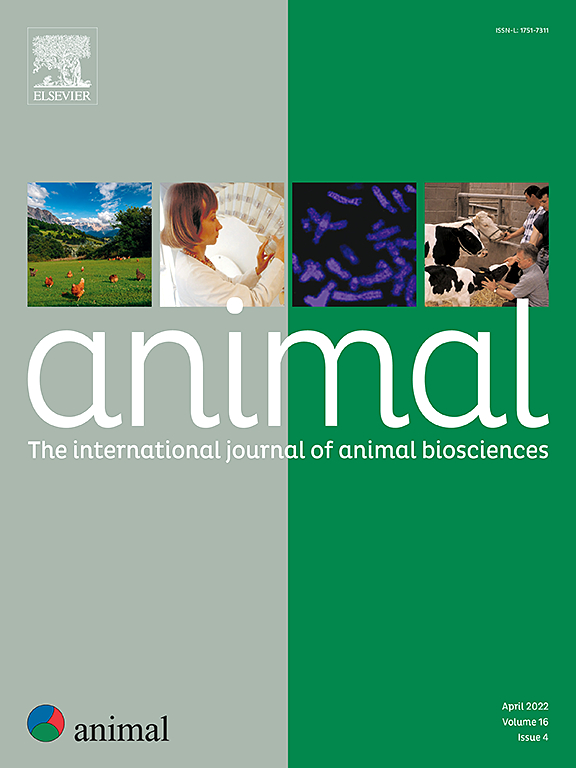与传统的单一马厩相比,两岁运动马在预训练期间的集体住房增加了警觉性和社会互动
IF 4.2
2区 农林科学
Q1 AGRICULTURE, DAIRY & ANIMAL SCIENCE
引用次数: 0
摘要
训练中的马通常是单独圈养的,但这一点越来越受到质疑。在为期12周的预训练计划中,我们研究了不同的马厩系统对温血种马的影响。公马为24月龄,饲养在群厩(第24组,n = 9)或单独饲养箱(第24箱,n = 10),或30月龄,饲养在单独饲养箱(第30箱,n = 10)。皮质醇,心率,心率变异性(HRV),身体发育,损伤和选择的行为模式进行分析(1)从牧场转移到马厩,(2)之后,在预训练期间反复进行。唾液皮质醇浓度稳定后立即升高(P <;0.001)。这种增加在24组种马中最为明显(P = 0.044)。2-3天后重新建立了皮质醇的昼夜节律,但在整个训练前阶段,24组的雄性马的唾液皮质醇浓度偶尔出现不规则的升高。对稳定的反应,心率也增加了大约3小时(P <;0.001),其中24组种马的上升最为显著(时间×组P <;0.001)。体重稳定后短暂下降(P <;0.001)。皮肤损伤主要是表面擦伤,在集体饲养的种马中比单独饲养的种马更常见(P <;0.001)。单独饲养的种马比集体饲养的种马更容易撒谎(P <;0.001)。相互梳理毛发只发生在第24组(P <组;0.001)。24组种马主要在早晨(时间P <;0.001, P <组;0.001)。单独饲养的种马比集体饲养的种马更明显,但偶尔也会在单独饲养的种马中看到(P <组;0.001)。在单独饲养的种马中,主要观察到在上午喂食前抓地,而在下午几乎没有(时间P <;0.001, P <组;0.001)。综上所述,皮质醇浓度、心率、HRV和行为在一定程度上表明,群养种马在训练前比单独饲养的种马受到更大的挑战。在本研究的条件下,对于两到三岁的种马,个体和群体马厩都是可以接受的,没有证据表明一种住房系统比另一种有重大优势。本文章由计算机程序翻译,如有差异,请以英文原文为准。
Group housing increases alertness and social interaction compared to traditional single stabling in two-year-old sport horse stallions during pretraining
Horses in training are often stabled individually, but this is increasingly questioned. We have investigated the effects of different stabling systems in Warmblood stallions during a 12-week pretraining programme. Stallions were 24 months old and housed either in a group stable (Group 24, n = 9) or in individual boxes (Box 24, n = 10), or they were 30 months of age and housed in individual boxes (Box 30, n = 10). Cortisol, heart rate, heart rate variability (HRV), body development, injuries and selected behaviour patterns were analysed (1) at transfer from pasture to stable and (2) thereafter, repeatedly during pretraining. Salivary cortisol concentration increased immediately after stabling (P < 0.001). This increase was most pronounced in Group 24 stallions (P = 0.044). A diurnal cortisol rhythm was re-established after 2–3 days, but occasional irregular increases in salivary cortisol concentration occurred in Group 24 stallions throughout the pretraining period. In response to stabling, also heart rate increased for approximately 3 h (P < 0.001) with a most pronounced rise in Group 24 stallions (time × group P < 0.001). BW decreased transiently after stabling (P < 0.001). Skin lesions were mainly superficial abrasions, and they were more frequent in group-housed vs individually stabled stallions (P < 0.001). Lying bouts were more frequent in individually housed than in group-housed stallions (P < 0.001). Mutual grooming occurred only in Group 24 stallions (group P < 0.001). Playing was seen in Group 24 stallions predominantly in the morning (time P < 0.001, group P < 0.001). Agonistic behaviour was more evident in individually housed than in group-housed stallions but was seen occasionally in individually housed stallions (group P < 0.001). Pawing the ground was mainly observed in individually housed stallions in the morning before feeding and was close to absent in the afternoons (time P < 0.001, group P < 0.001). In conclusion, cortisol concentration, heart rate, HRV and behaviour suggest that group-housed stallions, to some extent, were more challenged during the pretraining period than individually housed stallions. Under the conditions of this study, both individual and group stabling are acceptable for two- to three-year-old stallions and there was no evidence for a major advantage of one housing system over the other.
求助全文
通过发布文献求助,成功后即可免费获取论文全文。
去求助
来源期刊

Animal
农林科学-奶制品与动物科学
CiteScore
7.50
自引率
2.80%
发文量
246
审稿时长
3 months
期刊介绍:
Editorial board
animal attracts the best research in animal biology and animal systems from across the spectrum of the agricultural, biomedical, and environmental sciences. It is the central element in an exciting collaboration between the British Society of Animal Science (BSAS), Institut National de la Recherche Agronomique (INRA) and the European Federation of Animal Science (EAAP) and represents a merging of three scientific journals: Animal Science; Animal Research; Reproduction, Nutrition, Development. animal publishes original cutting-edge research, ''hot'' topics and horizon-scanning reviews on animal-related aspects of the life sciences at the molecular, cellular, organ, whole animal and production system levels. The main subject areas include: breeding and genetics; nutrition; physiology and functional biology of systems; behaviour, health and welfare; farming systems, environmental impact and climate change; product quality, human health and well-being. Animal models and papers dealing with the integration of research between these topics and their impact on the environment and people are particularly welcome.
 求助内容:
求助内容: 应助结果提醒方式:
应助结果提醒方式:


